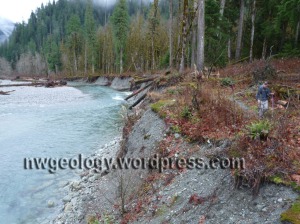Dear friends,
Mount Baker Volcano Research Center is offering a field trip up the Baker River on June 8th. It is a fundraiser for the non-profit, and I’ll be leading it, along with Doug McKeever (Whatcom Community College) and Sue Madsen (Skagit Fisheries Enhancement).
Highlights include:
- Shuksan greenschist (metamorphosed subducted seafloor basalt) which is the local bedrock;
- new salmon restoration facilities;
- an active alluvial fan;
- river erosion and deposition;
- a great variety of rocks in river bars;
- rock slides;
- a fantastic ‘faerie forest’ of lichen-draped maples.
- If the weather be good- fabulous views into the heart of the North Cascades.
Cost is $75, includes van transport and a trip guide.
For info and registration, go to:

An unnamed waterfall plummets hundreds of feet over a wall of metamorphic bedrock along the trail. Click to enlarge any photo.
Filed under: Geology field trips, guided field trips, metamorphic rocks, Mount Baker Volcano Research Center, News and notes, North Cascades geology | Tagged: alluvial fan, Baker Lake, Baker River, Dave Tucker, Doug Mckeever, Mount Baker Volcano Research Center, salmon habitat, Shuksan Greenschist, Sue Madsen |




Hi,
I cannot make the trip to the Baker River trail. However, I have a question about that area. I think I understand that the green rock in the river is probably Shuksan greenschist according to your post. However, I am puzzled about the orange stone. It looks like stone which is stained with iron. There are some that are all orange, some half and some with spots of it. It seems like a certain kind of rock is orange and others do not have it. In the Boulder Creek drainage, the orange stain is all through the channels which once held water. Some boulders are half orange with the bottom stained and some with the top stained. The Boulder Creek rocks are volcanic cinder types while those on the Baker River seem to be very dense.
I have someone who looked at one of the rocks and guessed it was basalt. Is that close?
thanks, Arlyn Ubben
Arlyn,
Sorry you can’t make the trip. In any case, the van is full and we have just closed registration.
You are correct, the green stone in the photos on the field trip description https://nwgeology.wordpress.com/the-fieldtrips/baker-river-trail-geology-green-green-green-rocks-moss-water/ is aptly-named greenschist, a metamorphosed sea floor basalt. Orange-colored rocks in general oxidized contain iron that is oxidized (just like rusty iron or steel). Their is iron in most basalts. The rocks in the Boulder Creek drainage, a few miles south of the Baker River trailhead, are profounded oxidized. Those boulders are almost entirely iron-bearing andesite, a close relative of basalt, different only by having a bit more silica. The rocks in Boulder Creek were initially erupted from Mount Baker as lava flows and carried down the stream by erosive lahars and floods. Boulder Creek begins in Sherman Crater, and flows under Boulder Glacier. The chemistry of the stream is strongly influenced by the acidic conditions in the crater. Oxidation in Boulder Creek is intense due to the influence of acidic water from the crater. Rocks in this creek are much more strongly oxidized than anywhere else around the volcano, or anywhere else in the Cascades that I know of.
Dave